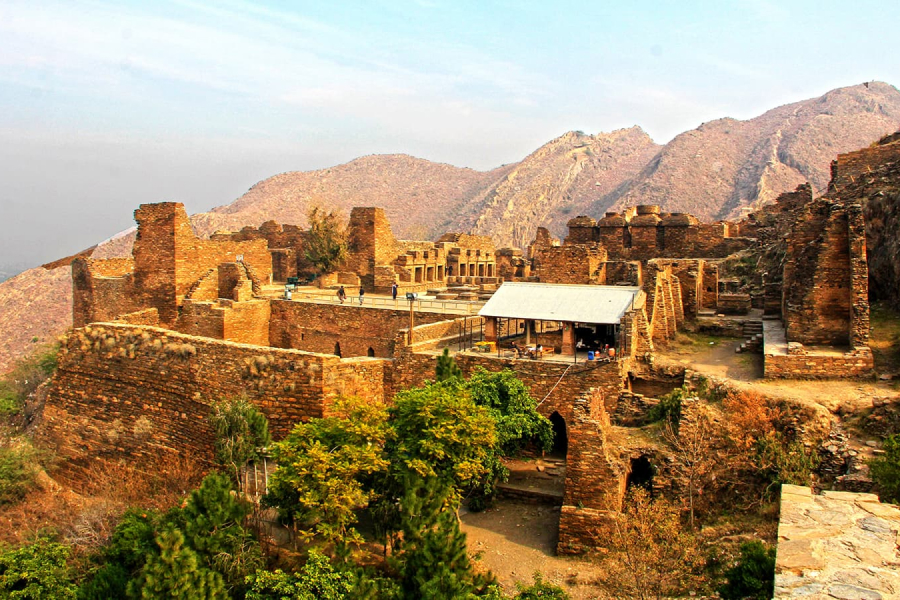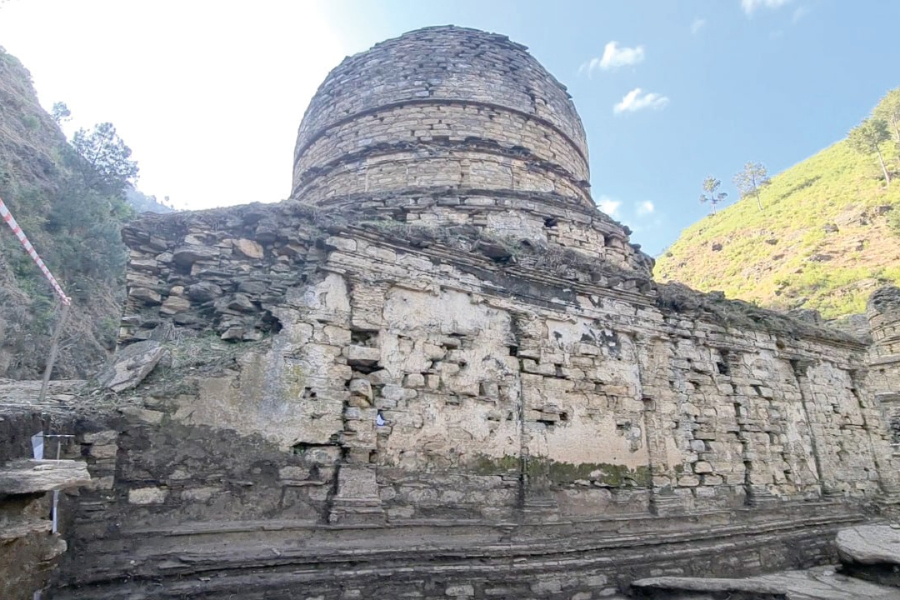The ancient land of Pakistan, with its rich historical tapestry, stands as a testament to the roots of Buddhism in South Asia. Dating back to the third century BCE under the Mauryan king Ashoka, Buddhism took root in the region, leaving a legacy of profound cultural and artistic influence. This three-part blog series will explore the fascinating history of Buddhist sites in Pakistan, their rise and decline, and current efforts to revive their cultural significance. If you’re intrigued by the allure of these ancient Buddhist sites and wish to embark on a transformative journey, consider joining our specialized Buddhist Pilgrimage Tour Pakistan.

FAQS:
1. What are the important Buddhist sites in Pakistan?
Pakistan boasts several significant Buddhist sites, reflecting the rich heritage of Gandhara and Ashoka. Some essential areas include:
- Taxila: An ancient city with numerous Buddhist stupas, monasteries, and artifacts.
- Takht-i-Bahi: A large Buddhist monastery in Khyber Pakhtunkhwa, listed as a UNESCO World Heritage site.
- Swat Valley: Home to many Buddhist towers, monasteries, and the famous Gandhara School of Sculpture.
- Gilgit-Baltistan: Features places like the Manthal Buddha Rock with eighth-century engravings.
2. What are the four essential sites of Buddhism?
The four essential sites associated with Buddhism are often referred to as the Four Holy Sites, connected to significant events in Buddha’s life:
- Lumbini: Birthplace of Siddhartha Gautama (Buddha) in present-day Nepal.
- Bodh Gaya: The site where Buddha attained enlightenment under the Bodhi tree.
- Sarnath: Where Buddha delivered his first sermon.
- Kushinagar: The place of Buddha’s death and attainment of parinirvana.
3. How many Buddhists are there in Pakistan?
The Buddhist population in Pakistan is relatively small. According to the National Database and Registration Authority (NADRA), 2017, there were approximately 1,884 Buddhists in the country. However, estimates suggest that the actual Buddhist population could exceed 16,000, with concentrations in Sindh and Punjab.
4. How many sites are there in Buddhism?
Buddhism has numerous significant sites worldwide, reflecting its spread and historical development. These include pilgrimage sites, monasteries, stupas, and archaeological remains. It is challenging to provide an exact count. Some notable sites are India, Nepal, Sri Lanka, Thailand, and other Asian countries. The number of sites is vast, encompassing places associated with Buddha’s life, teachings, and the development of Buddhist communities over the centuries.

Roots of Buddhism in Pakistan:
Ashoka’s Embrace:
The journey of Buddhism in Pakistan commenced in the third century BCE under the patronage of the Mauryan king Ashoka. His Major Rock Edicts, inscribed on boulders in Mansehra and Shahbaz Garhi, mark some of the earliest evidence of deciphered writing in South Asia. These inscriptions, in the Kharosthi script, recorded aspects of the emperor’s righteous law, providing a foundational glimpse into the principles of Buddhism.
Indo-Greek Influence:
The Indo-Greek king Menander further embraced Buddhism between 100 BCE and 200 AD, following a dialogue with the monk Nāgasena in present-day Sialkot. This cultural exchange and the subsequent flourishing of Greco-Buddhist art in the Gandhara region laid the groundwork for the prominence of Buddhism in the area.
The Flourishing Era:
Mahayana Buddhism, a significant branch today, is believed to have originated in Gandhara. Greco-Buddhist art and sculptures thrived, synthesizing Hellenistic and Indian elements. However, the golden era started to wane in the 6th century, facing challenges from the invasion by Alchon Huns.

Decline and Resurgence:
The decline continued with the Muslim conquests in the 14th century, leading to the disappearance of Buddhism in the Indian subcontinent. Fast forward to 2023, and the contemporary Buddhist population in Pakistan is minuscule, with only a few thousand individuals identified. Islamabad’s sole functional Buddhist temple reflects the small but resilient Buddhist community.
Heritage Exploration:
The country’s historical and cultural significance, particularly about Buddhism, is gaining attention, and efforts are being made to leverage this tourism potential.
Preservation Efforts:
Pakistan has initiated measures to preserve and promote its Buddhist heritage. The unveiling of the 48-foot-tall sleeping Buddha statue near the Bhamala Stupa in the Haripur region and the discovery of five hundred Buddhist-related objects in the same area are notable examples. The Sleeping Buddha, dating back to the 3rd century AD, is considered the oldest sleeping Buddha in the world. These discoveries contribute to enhancing Pakistan’s Buddhist site heritage.

Gandhara Heritage:
Pakistan is home to the ancient kingdom of Gandhara, which historically featured four capitals: Bagram, Charsadda, Taxila, and Peshawar. These capitals have been significant centers of Buddhist learning, producing many Buddhist philosophers and becoming crucial to the spread of Buddhism. Gandhara, meaning “Land of Perfume,” holds a central position in South, West, and Central Asia, attracting pilgrims from various regions.
Potential for Tourism Growth:
Despite past bureaucratic challenges and security concerns, Pakistan is actively working to tap into its tourism potential. Efforts include simplifying visa processes, improving security, and introducing online visas. In 2018, the British Backpackers Society ranked Pakistan the top tourist destination globally. With a renewed focus on Buddhist site tourism, Pakistan aims to attract visitors from China, Japan, Singapore, South Korea, and other countries.
Tourist Attractions:
Several Buddhist sites across Pakistan beckon tourists interested in exploring its rich heritage. Taxila, located in the modern state of Punjab, has been a Buddhist center for over 1,000 years, featuring sites like Bhirmound, Sirkap, Jandial Temple, and Taxila Museum. The Khyber Pakhtunkhwa province boasts the impressive Takht I Bahi, the largest Buddhist monument in the Gandhara region, and Swat Valley, once home to as many as 1,400 monasteries. Stupas in Gilgit-Baltistan and relics in Mohenjodaro, Sindh, further add to the diverse Buddhist heritage.

Museums, such as the Taxila Museum, preserve an impressive collection of Buddhist artifacts, including relics associated with Buddha. The Lahore Museum features a famous fasting Buddha statue from the Gandhara era. The importance of preserving and showcasing these artifacts extends beyond the borders of Pakistan, with relics like the Buddha’s tooth and bone being sent to travel to other countries.
International Recognition:
Pakistan’s Buddhist heritage is gaining international recognition, particularly among Buddhist tourists from Japan, China, Korea, India, Thailand, and beyond. The potential for growth in Buddhist tourism is significant, given that Buddhism is one of the most prominent spiritual paths globally, with over 520 million followers.
Conclusion:
Pakistan’s Buddhist heritage holds immense potential for tourism growth, and the country is making strides in preserving, promoting, and leveraging its historical and cultural treasures. The diverse range of Buddhist sites across different regions makes Pakistan an intriguing destination for those seeking to explore the roots of Buddhism. As the country continues its efforts to enhance tourism infrastructure and facilitate travel, it is poised to become a prominent hub for Buddhist tourism in the years to come. For adventurous souls, the enchanting Broad Peak Expedition Pakistan offers a thrilling opportunity to conquer one of the world’s highest peaks. If you are interested in embarking on a Buddhist pilgrimage to explore Pakistan’s rich heritage, consider the meticulously crafted Buddhist Pilgrimage Heritage in Pakistan tour by Jasmine Tours.”
Please visit Broad Peak Expedition Pakistan for more details of our exciting adventure.
For an immersive experience in the Buddhist heritage of Pakistan, explore the offerings of Buddhist Pilgrimage Heritage in Pakistan with Jasmine Tours.

